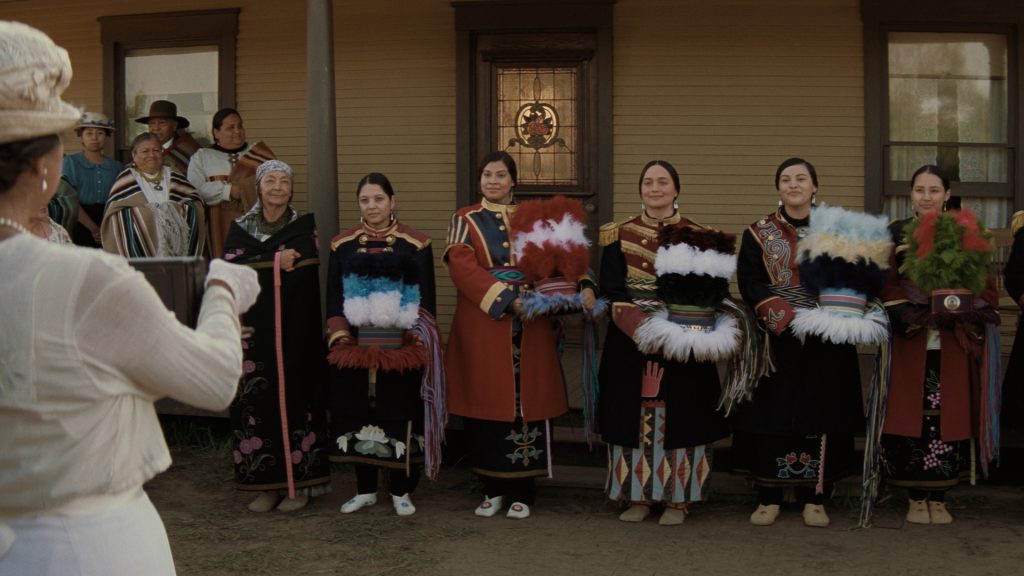By Jed Donahue

image courtesy of Apple Studios
It’s not often that Calvin Coolidge appears as a character in a Hollywood blockbuster. But that’s what he does—briefly—in Martin Scorsese’s new film, Killers of the Flower Moon.
Based on the bestselling book by David Grann, Killers of the Flower Moon tells the true story of a confounding series of murders in the 1920s. The killings targeted members of the Osage Nation in Oklahoma. By that point, the Osage had become the richest people in the world per capita, thanks to large oil deposits discovered beneath their land.
Like any Hollywood production, Killers of the Flower Moon takes some creative license with the historical record. So how much of its depiction of Coolidge is true?
The Osage at the White House
In the film, Mollie Burkhart (Lily Gladstone), an Osage woman, loses three sisters in mysterious circumstances. One dies of a peculiar “wasting illness.” Another is shot. A third is killed when a bomb destroys her house.
The movie shows Mollie hiring the well-known private detective William J. Burns, known as “America’s Sherlock Holmes.” In reality, the family did hire a team of private detectives, including some who had worked for the William J. Burns International Detective Agency. But Burns himself did not work the case.
In the early 1920s, in fact, Burns served as director of the Bureau of Investigation. This forerunner to the FBI would later, under J. Edgar Hoover, take control of the case. In 1923, Burns sent a Bureau agent to investigate the Osage murders. But as Grann reports in his book, after a few weeks the agent concluded that “any continued investigation is useless.”
Scorsese and Eric Roth, who wrote the Killers of the Flower Moon screenplay, compress and take liberties with this history. They show Mollie traveling to the White House and briefly meeting President Coolidge. There she pleads with the president for help.
Did this meeting happen?
Probably not. Grann recently told USA Today, “There is no evidence that I know of that Mollie spoke to the president about the murders.”
In real life, though, the Osage did travel to D.C. and meet with Coolidge. Photos captured the visit.
Coolidge and J. Edgar Hoover
The Bureau of Investigation, it turned out, did not give up on the Osage investigation. The film portrays agent Tom White (Jesse Plemons) traveling to Osage County to investigate. He has come to Oklahoma, he says, at the behest of J. Edgar Hoover.
Hoover, as acting director, did indeed send White to investigate. President Coolidge played a role in putting Hoover in that chair.
Hoover’s predecessor at the Bureau of Investigation, Burns, was a friend of Harry Daugherty, President Warren Harding’s attorney general. In March 1924, President Coolidge asked for Daugherty’s resignation. The swirl of scandals around the attorney general distracted from Coolidge’s tax-reform agenda.
Grann writes, “By the summer of 1924, Harding’s successor, Calvin Coolidge, had gotten rid of Burns and appointed a new attorney general, Harlan Fiske Stone.” It is more likely that Stone, Coolidge’s Amherst College classmate, ousted Burns. Coolidge biographer Amity Shlaes says that Stone “made his own calls at the Justice Department” and “removed” Burns from the Bureau.
Stone chose the twenty-nine-year-old Hoover to step in as acting director. It was also Stone who, in Grann’s words, “concluded that a national police force was indispensable.” Thus the attorney general set the Bureau of Investigation on its path to becoming the FBI we know today.
Grann argues that solving the Osage murders case led to the “birth of the FBI” (as his book’s subtitle has it). Yet Hoover tried to “dump the case back on state authorities,” Grann writes. The young director reversed course only after the Bureau made an embarrassing blunder.
Agents had enlisted a convicted bank robber, Blackie Thompson, to work undercover gathering evidence on the Osage killings. “But while the agents were supposed to keep Blackie under close surveillance, they’d lost him in the Osage Hills,” Grann writes. “He then proceeded to rob a bank. And kill a police officer. It took months for authorities to apprehend Blackie.”
So Tom White felt intense pressure from Hoover to solve the Osage case.
The agent came through. Killers of the Flower Moon, both the book and the film, tells the story of how he and the Bureau of Investigation cracked the case.
Support for Native Americans
President Coolidge may not have encountered Mollie Burkhart, but he “actively engaged with Native Americans as president,” Dr. Colleen Shogan points out. “Coolidge hosted Native Americans at the White House numerous times, publicly released posed photographs with them, and even visited a Native American tribal reservation in South Dakota.”
Coolidge may have felt a personal connection. In his Autobiography, he claimed that his great-grandmother’s family “showed a marked trace of Indian blood.”
Whatever the case, Coolidge supported and signed the law that made all Native Americans citizens of the United States.
You won’t see that history in Killers of the Flower Moon, which focuses on the tragedy of the Osage murders. But as with so many other things Coolidge, the real story is more complex.
Outside Washington, Coolidge is my favorite POTUS! Reversing the racist policies of democrat Woodrow Wilson and PAYING DOWN the national debt, he is unrivalled. Surprised Hollywood didn’t have Coolidge wearing a Klan robe and chewing tobacco while calling every Osage “chief”!
RIP Mr. President ❤️☦️🇺🇸🇵🇷
very informative. I look forward to seeing the movie.